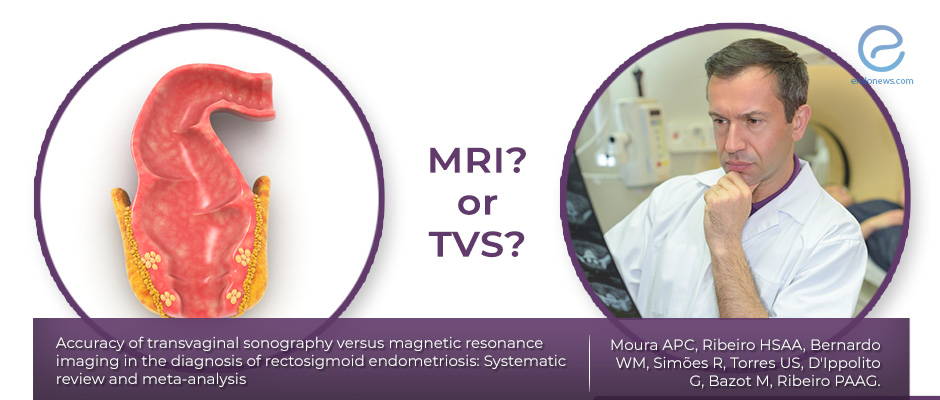MRI or TVS for accurate diagnosis of rectosigmoid endometriosis?
Jul 15, 2019
The state of art for diagnostic imaging of Rectosigmoid Endometriosis should combine MRI and Transvaginal Sonography
Key Points
Highlights:
- Both MRI and Transvaginal Sonography (TVS) showed high accuracy in the noninvasive diagnosis of Rectosigmoid Endometriosis (RE).
- Combination of MRI and TVS may yield near 100% accuracy.
Importance:
- The rectosigmoid is involved in about 90% of cases of bowel endometriosis, which is considered the most severe form of deep endometriosis. In the last two decades, several studies have examined the accuracy of imaging modalities such as TVS and MRI for the diagnosis of deep endometriosis; however, just a small subset of them separately addressed the rectosigmoid region, and there has been no consensus regarding which method is the most accurate for diagnosis of endometriosis in this region.
What’s done here?
- A systematic review and meta-analysis to compare the accuracy of TVS versus MRI in the diagnosis of RE in the same population.
- Eight studies (n = 1132) were included in the meta-analysis.
Key results:
- There is no statistically significant difference between MRI and TVS in the diagnosis of rectosigmoid endometriosis. Both methods demonstrated similarly high accuracy, and their combined use yielded a 99.6% accuracy.
Limitations of the study:
- This study did not consider the characteristics of endometriotic lesions in the evaluation of the diagnostic accuracy of these methods. Characteristics such as size, maximum depth of the affected layer, and circumference are vital for surgical planning.
Lay Summary
Rectosigmoid endometriosis (RE) is seen in about 90% of patients with bowel endometriosis. Rectosigmoid is the region between the rectum and the sigmoid colon, which is a region easily accessed and assessed by two most common noninvasive imaging modalities – transvaginal sonography (TVS) or magnetic resonance imaging (MRI). Either method was found, by this study, highly accurate for noninvasive diagnosis and pre-operative mapping of RE.
Noninvasive means of diagnosis is treasured by patients with deep endometriosis, as they generally go through numerous examinations over many years it takes to receive a final diagnosis after the first symptom onset.
The current work by Moura et al., recently published in PLOS One journal, is a systematic review and meta-analysis of available data from studies comparing the diagnostic accuracy of TVS and MRI for rectosigmoid endometriosis in the same set of patients. Eight studies with a total of 1132 patients who underwent TVS and MRI for suspected endometriosis, based on clinical history (pelvic pain or infertility) and/or physical examination (pain and nodularity on palpation) were included.
The results showed that MRI and TVS have similar performance in the diagnosis of rectosigmoid endometriosis. The combined use of TVS and MRI rises the chance of noninvasively and accurately diagnosing RE practically to 100% when both examinations yield positive results.
When it comes to choosing one or the other though, many aspects of each should be considered. While the ultrasonography is a safe, low cost, and widespread technique with similar diagnostic accuracy to MRI; it is also operator-dependent. The technique and experience of the operator as well as equipment quality contribute greatly to the interpretations and diagnoses via ultrasound. MRI costs more, but also provides distinct technological advantages over the ultrasound. Thus, the decision to use one method over the other ultimately depends on the availability of each method, costs, and radiologists’ experience with each method. The authors added: “In an ideal scenario (an institution with high expertise in imaging of endometriosis), we think that TVS could be used as an initial method, while MRI could be reserved in doubtful cases or to rise the post-test probabilities to near 100%. Moreover, MRI could be used in the preoperative planning of patients selected for surgical treatment.”
In recent decades, TVS and MRI have been shown to be more accurate than other imaging methods (i.e., transrectal sonography, barium enema, computed tomography colonography) in the detection of RE; they are also noninvasive and do not require sedation. “The state of the art in the diagnostic imaging management of RE should combine these two methods” concluded the authors. Both examinations can be performed on the same day, requiring a single bowel preparation, which the authors believe is important to increase the detection rate of small lesions.
Research Source: https://www.ncbi.nlm.nih.gov/pubmed/30964888
MRI or TVS for accurate diagnosis of rectosigmoid endometriosis?

